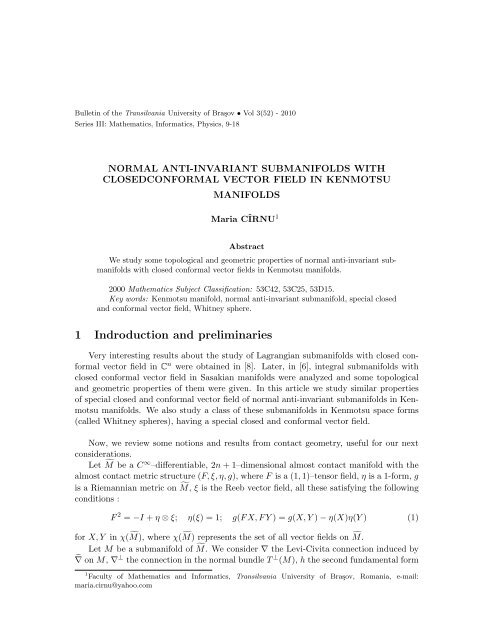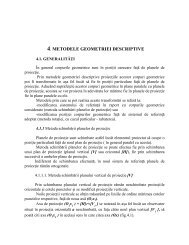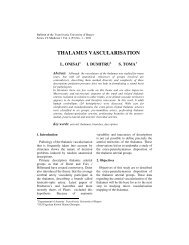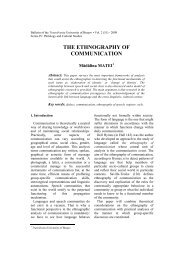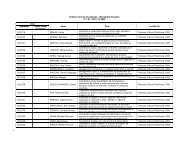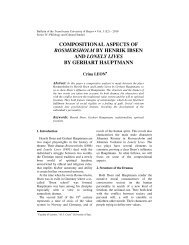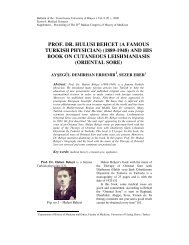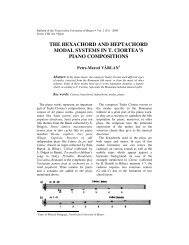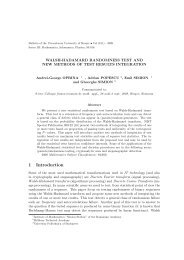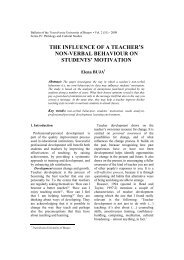Cirnu M., Normal anti-invariant submanifolds with closed conformal ...
Cirnu M., Normal anti-invariant submanifolds with closed conformal ...
Cirnu M., Normal anti-invariant submanifolds with closed conformal ...
Create successful ePaper yourself
Turn your PDF publications into a flip-book with our unique Google optimized e-Paper software.
Bulletin of the Transilvania University of Braşov • Vol 3(52) - 2010<br />
Series III: Mathematics, Informatics, Physics, 9-18<br />
NORMAL ANTI-INVARIANT SUBMANIFOLDS WITH<br />
CLOSEDCONFORMAL VECTOR FIELD IN KENMOTSU<br />
MANIFOLDS<br />
Maria CÎRNU 1<br />
Abstract<br />
We study some topological and geometric properties of normal <strong>anti</strong>-<strong>invariant</strong> <strong>submanifolds</strong><br />
<strong>with</strong> <strong>closed</strong> <strong>conformal</strong> vector fields in Kenmotsu manifolds.<br />
2000 Mathematics Subject Classification: 53C42, 53C25, 53D15.<br />
Key words: Kenmotsu manifold, normal <strong>anti</strong>-<strong>invariant</strong> submanifold, special <strong>closed</strong><br />
and <strong>conformal</strong> vector field, Whitney sphere.<br />
1 Indroduction and preliminaries<br />
Very interesting results about the study of Lagrangian <strong>submanifolds</strong> <strong>with</strong> <strong>closed</strong> <strong>conformal</strong><br />
vector field in C n were obtained in [8]. Later, in [6], integral <strong>submanifolds</strong> <strong>with</strong><br />
<strong>closed</strong> <strong>conformal</strong> vector field in Sasakian manifolds were analyzed and some topological<br />
and geometric properties of them were given. In this article we study similar properties<br />
of special <strong>closed</strong> and <strong>conformal</strong> vector field of normal <strong>anti</strong>-<strong>invariant</strong> <strong>submanifolds</strong> in Kenmotsu<br />
manifolds. We also study a class of these <strong>submanifolds</strong> in Kenmotsu space forms<br />
(called Whitney spheres), having a special <strong>closed</strong> and <strong>conformal</strong> vector field.<br />
Now, we review some notions and results from contact geometry, useful for our next<br />
considerations.<br />
Let ˜M be a C ∞ –differentiable, 2n + 1–dimensional almost contact manifold <strong>with</strong> the<br />
almost contact metric structure (F, ξ, η, g), where F is a (1, 1)–tensor field, η is a 1-form, g<br />
is a Riemannian metric on ˜M, ξ is the Reeb vector field, all these satisfying the following<br />
conditions :<br />
F 2 = −I + η ⊗ ξ; η(ξ) = 1; g(F X, F Y ) = g(X, Y ) − η(X)η(Y ) (1)<br />
for X, Y in χ(˜M), where χ(˜M) represents the set of all vector fields on ˜M.<br />
Let M be a submanifold of ˜M. We consider ∇ the Levi-Civita connection induced by<br />
˜∇ on M, ∇ ⊥ the connection in the normal bundle T ⊥ (M), h the second fundamental form<br />
1 Faculty of Mathematics and Informatics, Transilvania University of Braşov, Romania, e-mail:<br />
maria.cirnu@yahoo.com
10 Maria Cîrnu<br />
on M ¸and A ⃗n the Weingarten operator. The well-known Gauss–Weingarten formulas on<br />
M are:<br />
˜∇ X Y = ∇ X Y + h(X, Y ); ˜∇X ⃗n = −A ⃗n X + ∇ ⊥ X⃗n (2)<br />
for X, Y in χ(M) and ⃗n in χ ⊥ (M), where χ ⊥ (M) represents the set of normal vector fields<br />
on M.<br />
We also consider the fundamental 2-form Ω on ˜M, given by Ω(X, Y ) = g(X, F Y ) and<br />
denote by N F the Nijenhius tensor of F . It is known that ˜M is a Kenmotsu manifold if<br />
and only if<br />
dη = 0; dΩ = 2η ∧ Ω; N (1) = N F + 2dη ⊗ ξ = 0,<br />
or equivalently<br />
( ˜∇ X F )Y = g(Y, F X)ξ − η(Y )F X, (3)<br />
for X, Y in χ(˜M).<br />
A submanifold M, normal to the Reeb vector field ξ in a Kenmotsu manifold ˜M, is a<br />
normal semi-<strong>invariant</strong> submanifold, [7], if there are D, D ⊥ two orthogonal distributions<br />
on M so that:<br />
1. T x M = D x ⊕ D ⊥ x ;<br />
2. D is <strong>invariant</strong>, that is F D x = D x ;<br />
3. D ⊥ is <strong>anti</strong>-<strong>invariant</strong>, that is F D ⊥ x ⊆ T ⊥ x M,<br />
for all x in M, where T x M represents the tangent space in x on M and T ⊥ x M the normal<br />
space in x on M. Moreover, if D ⊥ = 0 then M is a normal <strong>invariant</strong> submanifold of ˜M,<br />
and if D = 0 then M is a normal <strong>anti</strong>-<strong>invariant</strong> submanifold of ˜M.<br />
An important property on these <strong>submanifolds</strong>, given in [7], and useful for our considerations<br />
is the following:<br />
Proposition 1. Let M be a normal semi-<strong>invariant</strong> submanifold of the Kenmotsu manifold<br />
˜M. Then:<br />
i) A F X Y = A F Y X, for all X, Y ∈ D ⊥ ;<br />
ii) A ξ Z = −Z and ∇ ⊥ Zξ = 0, for all Z ∈ χ(M).<br />
From [4], we have the following expression of the curvature tensor in Kenmotsu space<br />
forms:<br />
˜R(X, Y )Z = c − 3 [g(Y, Z)X − g(X, Z)Y ] + c + 1<br />
4<br />
4 [η(X)η(Z)Y<br />
− η(Y )η(Z)X + g(X, Z)η(Y )ξ − g(Y, Z)η(X)ξ + Ω(X, Z)F Y<br />
− Ω(Y, Z)F X + 2Ω(X, Y )F Z], (4)<br />
for all X, Y, Z ∈ χ(˜M), where ˜R is the curvature tensor of ˜M.
<strong>Normal</strong> <strong>anti</strong>-<strong>invariant</strong> <strong>submanifolds</strong> <strong>with</strong> <strong>closed</strong> <strong>conformal</strong> vector field 11<br />
2 Some properties of normal <strong>anti</strong>-<strong>invariant</strong> <strong>submanifolds</strong> of<br />
a Kenmotsu manifold<br />
Let M be an m-dimensional normal <strong>anti</strong>-<strong>invariant</strong> submanifold of 2n + 1-dimensional<br />
Kenmotsu manifold ˜M. Because ξ⊥M, F /TxM is one to one, for x ∈ M, we obtain that<br />
m ≤ n. We consider the following descomposition:<br />
T ⊥ x M = F T x M ⊕ τ x (M)⊕ < ξ x >,<br />
where τ x (M) is the complement of F T x M⊕ < ξ x > in T ⊥ x M. We also consider the bundles<br />
F T M = ⋃ x∈M F T xM, τ(M) = ⋃ x∈M τ x(M). Let {e 1 , ..., e m } be an orthonormal basis on<br />
M. Then {F e 1 , ..., F e m } is an orthonormal basis of F T M and we consider {e 2m+1 , ..., e 2n }<br />
an orthonormal basis in τ(M) and put e 2n+1 = ξ.<br />
For X, Y ∈ χ(M) we denote by h τ (X, Y ) and h F (X, Y ) the component of h(X, Y ) on<br />
τ(M) and on F T M, respectively.<br />
Using (2), (3) and Proposition 1. ii), we obtain the following proposition:<br />
Proposition 2. If M is m-dimensional then:<br />
∇ ⊥ ◦ F = F ◦ ∇ + F ◦ h τ ; F ◦ h F + A F = 0; h = h F + h τ − g ⊗ ξ. (5)<br />
Remark 1. If M is an n-dimensional normal <strong>anti</strong>-<strong>invariant</strong> submanifold of 2n + 1- dimensional<br />
Kenmotsu manifold ˜M, then τ(M) = 0, h τ = 0 and<br />
We define the 3-form<br />
∇ ⊥ ◦ F = F ◦ ∇; h = h F − g ⊗ ξ. (6)<br />
C F : χ(M) × χ(M) × χ(M) → F(M); C F (X, Y, Z) = g(h F (X, Y ), F Z), (7)<br />
for all X, Y, Z ∈ χ(M), where F(M) is the set of all real valued smooth functions on<br />
M. From the symmetry of h, Proposition 1 and (5), it results that C F is symmetric and<br />
3-linear.<br />
Proposition 3. Let M be an m-dimensional normal <strong>anti</strong>-<strong>invariant</strong> submanifold of 2n+1-<br />
dimensional Kenmotsu manifold ˜M. Then the 3-linear form ∇C F is symmetric in X and<br />
Y .<br />
Proof. By a straighforward computation and using the properties of Levi-Civita connection,<br />
Proposition 1, (2), (3), (5) and the definitions of ∇h F and ∇C F , we obtain:<br />
g((∇ X h F )(Y, Z) − (∇ Y h F )(X, Z), F U)<br />
= X(g(h F (Y, Z), F U)) − g(h F (∇ X Y, Z), F U) − g(h F (Y, ∇ X Z), F U)<br />
− g(h F (Y, Z), F ∇ X U) − Y (g(h F (X, Z), F U)) + g(h F (∇ Y X, Z), F U)<br />
+ g(h F (X, ∇ Y Z), F U) + g(h F (X, Z), F ∇ Y U)<br />
= (∇ X C F )(Y, Z, U) − (∇ Y C F )(X, Z, U), (8)
12 Maria Cîrnu<br />
for all X, Y, Z, U ∈ χ(M). Moreover, because M is a normal <strong>anti</strong>-<strong>invariant</strong> submanifold,<br />
from (4), we have:<br />
[ ˜R(X, Y )Z] ⊥ = 0,<br />
for all X, Y, Z ∈ χ(M). Now, from the Codazzi equation and (8), it results that ∇C F is<br />
symmetric in X and Y .<br />
For ⃗n ∈ χ ⊥ (M), we consider the 1-form α ⃗n : χ(M) → F (M), given by<br />
for all X ∈ χ(M). We have the following proposition:<br />
α ⃗n (X) = g(F⃗n, X), (9)<br />
Proposition 4. Let M be an m-dimensional normal <strong>anti</strong>-<strong>invariant</strong> submanifold of 2n+1-<br />
dimensional Kenmotsu manifold ˜M. Then:<br />
i) α ⃗n is <strong>closed</strong> if and only if<br />
for all X, Y ∈ χ(M),<br />
ii) α ⃗n = 0, for all ⃗n ∈ τ(M)⊕ < ξ >.<br />
g(∇ ⊥ Y ⃗n, F X) = g(∇ ⊥ X⃗n, F Y ), (10)<br />
Proof. i) From the properties of Levi-Civita connection and (3), it results:<br />
(dα ⃗n )(X, Y ) = −g(∇ ⊥ X⃗n, F Y ) + g(∇ ⊥ Y ⃗n, F X)<br />
and then (10).<br />
ii) results from (9) and the descomposition of χ ⊥ (M) = F T M ⊕ τ(M)⊕ < ξ > .<br />
A vector field X on a normal <strong>anti</strong>-<strong>invariant</strong> submanifold M of a Kenmotsu manifold<br />
˜M is <strong>closed</strong> if α F X is a <strong>closed</strong> 1-form.<br />
Proposition 5. Let M be an m-dimensional normal <strong>anti</strong>-<strong>invariant</strong> submanifold of a 2n+<br />
1-dimensional Kenmotsu manifold ˜M. If one of the following conditions is satisfied:<br />
i) M has parallel mean curvature vector ;<br />
ii) m = n,<br />
then F H is a <strong>closed</strong> vector field.<br />
Proof. i) Let H be the mean curvature vector of M. Because M is parallel, we have (10),<br />
that is α H is a <strong>closed</strong> form. Then α F 2 H = α −H+η(H)ξ = −α H is <strong>closed</strong>.<br />
ii) m = n implies H = H F and α F H (X) = g(F 2 H, X) = g(−H + η(H)ξ, X) = 0, for<br />
X ∈ χ(M).<br />
Definition 1. Let M be a normal <strong>anti</strong>-<strong>invariant</strong> submanifold of a Kenmotsu manifold ˜M.<br />
A vector field X ∈ χ(M) is a <strong>closed</strong> <strong>conformal</strong> vector field if<br />
i) X is <strong>closed</strong>;<br />
ii) X is <strong>conformal</strong>, that is<br />
g(∇ Y X, Z) + g(∇ Z X, Y ) =<br />
2<br />
div(X), (11)<br />
dim M
<strong>Normal</strong> <strong>anti</strong>-<strong>invariant</strong> <strong>submanifolds</strong> <strong>with</strong> <strong>closed</strong> <strong>conformal</strong> vector field 13<br />
for all Y, Z ∈ χ(M), where div(X) represents the divergence of X.<br />
Moreover, if there is f ∈ F (M) such as h(X, X) = fF X, then X is a special <strong>closed</strong><br />
<strong>conformal</strong> vector field on M.<br />
Remark 2. Conditions i) and ii) from Definition 1 are equivalent to:<br />
for all Y ∈ χ(M).<br />
We consider<br />
∇ Y X = div(X) Y, (12)<br />
dim M<br />
L = { Y/Y ∈ χ(M), g(F H F , Y ) = 0 } . (13)<br />
Proposition 6. Let M be a m-dimensional normal <strong>anti</strong>-<strong>invariant</strong> submanifold of a 2n+1-<br />
dimensional Kenmotsu manifold ˜M and X a <strong>closed</strong> special <strong>conformal</strong> vector field on M.<br />
Then:<br />
i) X is an eigenvector of A F X , corresponding to the eigenvalue f;<br />
ii) Y is an eigenvector of A F X , corresponding to the eigenvalue λ if and only if<br />
h F (X, Y ) = λF X;<br />
∇ ⊥ Y (F X) = div(X)<br />
m F Y + F hτ (X, Y ); (14)<br />
iii) for all Y, Z ∈ L eigenvectors, corresponding to different eigenvalues of A F X , Y, Z<br />
are orthogonal and C F (X, Y, Z) = 0.<br />
Proof. i) From (5), A F X X = −F h F (X, X) = −F (fX) = −fF 2 X = fX.<br />
ii) Let Y be a an eigenvector corresponding to A F X <strong>with</strong> λ its eigenvalue. From (5),<br />
A F X Y = −F h F (X, Y ) = λY and then h F (X, Y ) = λF Y . Because h F is symmetric, we<br />
have h F (Y, X) = λF X and then h F (X, Y ) = λF X.<br />
The second equality results from (2), (3) and (12).<br />
iii) Let λ 1 be the eigenvalue of Y and λ 2 the eigenvalue of Z, so that λ 1 ≠ λ 2 . We<br />
have C F (Y, Z, X) = g(h(Y, Z), F X) = g(A F X Y, Z) = λ 1 g(Y, Z) and C F (Z, Y, X) =<br />
g(h(Z, Y ), F X) = g(A F X Z, Y ) = λ 2 g(Z, Y ). The affirmation results from the fact that<br />
C F is symmetric and λ 1 ≠ λ 2 .<br />
Now, we recall from [8] two lemmas, useful for our next considerations:<br />
Lemma 1. Let X be a nontrivial, <strong>closed</strong> and <strong>conformal</strong> vector field on an n-dimensional<br />
Riemannian manifold M <strong>with</strong> the metric g. Then:<br />
i) The curvature tensor R of M satisfies the equation:<br />
‖X‖ 2 R(V, W )X = Ric(X) [g(W, X) − g(V, X)W ]; (15)<br />
n − 1<br />
ii) IF M ′ = {p ∈ M/X p ≠ 0}, then the distribution<br />
defines an umbilical foliation on M.<br />
D : p ∈ M ′ → D(p) = {V ∈ T p M/g(V, X) = 0}
14 Maria Cîrnu<br />
Lemma 2. Let ψ : M → C n be a Lagrangian immersion of an n- dimensional manifold M<br />
and X a <strong>closed</strong> and <strong>conformal</strong> vector field <strong>with</strong>out zeroes on M so that h(X, X) = fF X,<br />
where f is a differential function on M and F is the hermitian structure on M. Then:<br />
i) For any point p ∈ M, there are at most two eigenvalues of A F X on D(p) which<br />
satisfy the quadric equation:<br />
λ 2 − fλ + Ric(X)<br />
n − 1<br />
= 0, (16)<br />
where Ric represents the Ricci tensor of M. Moreover, the eigenvalues of A F X are constant<br />
on the connected leaves of the foliation D.<br />
ii) IF V, W ∈ D(p) are eigenvectors of A F X , corresponding to different eigenvalues,<br />
then h(V, W ) = 0.<br />
Proposition 7. Let M be an m-dimensional <strong>anti</strong>-<strong>invariant</strong> submanifold of the 2n + 1-<br />
dimensional Kenmotsu space form ˜M(c). We consider X a <strong>closed</strong> special <strong>conformal</strong> vector<br />
field on M and L X = {Y ∈ χ(M)/g(X, Y ) = 0}. If Y ∈ L X , Y ≠ 0, is an eigenvector of<br />
A F X , corresponding to eigenvalue λ, then:<br />
λ 2 − fλ + Ric(X)<br />
m − 1 − c − 3 ‖X‖ 2 + 1<br />
4 ‖Y ‖ 2 ‖hτ (X, Y )‖ 2 = 0. (17)<br />
Proof. From the Gauss equation, we obtain:<br />
g( ˜R(X, Y )X, Y ) = g(R(X, Y )X, Y ) − g(h(X, Y ), h(X, Y )) + g(h(X, X), h(Y, Y )), (18)<br />
where R is the curvature tensor of M. Because X is special, Y ∈ L X , using the descomposion<br />
(5) of h(X, Y ), it results that<br />
g(h(Y, Y ), h(X, X)) = fλ ‖Y ‖ 2 ; g(h(X, Y ), h(X, Y )) = λ 2 ‖Y ‖ 2 + ‖h τ (X, Y )‖ 2 .<br />
From (15), we have R(X, Y )X = − Ric(X)<br />
m−1 Y and from (4), ˜R(X, Y )X = −<br />
c−3<br />
4 ‖X‖2 Y .<br />
Using these last relations in (18), we obtain the desired result.<br />
From Proposition 7 and Lemma 2, it results:<br />
Proposition 8. If M is an n-dimensional normal <strong>anti</strong>-<strong>invariant</strong> submanifold of 2n + 1-<br />
dimensional Kenmotsu space form ˜M(c) and X is a special <strong>closed</strong> <strong>conformal</strong> vector field<br />
on M, then:<br />
i) A F X has at most three eigenvalues f, λ 1 , λ 2 in any point of M, where λ 1 , λ 2 verify<br />
the equation:<br />
λ 2 − fλ + Ric(X)<br />
n − 1 − c − 3 ‖X‖ 2 = 0;<br />
4<br />
ii) the eigenvalues λ 1 and λ 2 of A F X are constant on the connected leaves of the<br />
foliation L.
<strong>Normal</strong> <strong>anti</strong>-<strong>invariant</strong> <strong>submanifolds</strong> <strong>with</strong> <strong>closed</strong> <strong>conformal</strong> vector field 15<br />
Proposition 9. Let M be a normal <strong>anti</strong>-<strong>invariant</strong> submanifold in Kenmotsu space form<br />
˜M(c) <strong>with</strong> dim M ≥ 2. If X is a nontrivial parallel vector field on M such as h(X, X) =<br />
fF X, then f = constant.<br />
Proof. Because X is special, using (3), the properties of Levi-Civita connection, the definition<br />
of ∇C F and the fact that X is parallel, for Y, Z ∈ χ(M), we obtain:<br />
g( ˜∇ Y (h(X, X)), F Z) = Y (f)g(X, Z); (∇ Y C F )(X, X, Z) = Y (f)g(X, Z).<br />
Now, from the symmetry of ∇C F , we have X(f)g(Y, Z) = Y (f)g(X, Z) and then f =<br />
constant.<br />
3 Whitney sphere of a Kenmotsu manifold<br />
Definition 2. An n-dimensional normal <strong>anti</strong>-<strong>invariant</strong> submanifold M of the 2n + 1-<br />
dimensional Kenmotsu manifold ˜M is a Whitney sphere if its second fundamental form h<br />
satisfies the equation:<br />
h(V, V ) = λ[g(V, V )H + 2g(H, F V )F V + 2 g(H, ξ)g(V.V )ξ], (19)<br />
n<br />
where H is the mean curvature vector field of M, V ∈ χ(M) and λ ∈ F (M).<br />
Remark 3. If M is a Whitney sphere of a Kenmotsu manifold, then λ =<br />
n<br />
n+2 . From<br />
Proposition 1.ii), g(H, ξ) = −1 and using the bilinearity and symmetry of h, we have:<br />
h(V, W ) = λ[g(V, W )H + g(H, F V )F W + g(H, F W )F V − 2 g(V, W )ξ], (20)<br />
n<br />
for all V, W ∈ χ(M).<br />
Theorem 1. If M is a Whitney sphere of Kenmotsu space form ˜M(c), then F H is a<br />
<strong>closed</strong> <strong>conformal</strong> vector field on M.<br />
Proof. Let Z, V be two vector fields M, so that V is an unitary vector field and Z⊥V .<br />
Using (4), we obtain ˜R(Z, V )V = c−3<br />
4<br />
and then [ ˜R(Z, V )V ] ⊥ = 0. From Codazzi equation,<br />
we obtain (∇ ⊥ Z h)(V, V ) = (∇⊥ V<br />
h)(Z, V ). By a straightforward computation, using the<br />
properties of Levi-Civita connection, (3), (5) and (20) we have:<br />
and then<br />
(∇ ⊥ Zh)(V, V ) = λ[∇ ⊥ ZH + 2g(∇ ⊥ ZH, F V )F V ];<br />
(∇ ⊥ V h)(Z, V ) = λ[g(∇ ⊥ V H, F V )F Z + g(∇ ⊥ V H, F Z)F V ]<br />
∇ ⊥ ZH + 2g(∇ ⊥ ZH, F V )F V = g(∇ ⊥ V H, F V )F Z + g(∇ ⊥ V H, F Z)F V. (21)<br />
From this last relation, it results g(∇ ⊥ Z H, F V ) + 2g(F V, ∇⊥ Z H) = g(∇⊥ V<br />
H, F Z). Because<br />
M is a Whitney sphere, from Proposition 5, F H is <strong>closed</strong> and from (10) we have<br />
g(F V, ∇ ⊥ Z H) = g(F Z, ∇⊥ V H) and then g(F V, ∇⊥ ZH) = 0. Moreover, using (21), we obtain:<br />
(∇ Z F H) = F ∇ ⊥ ZH = −g(F V, ∇ ⊥ V H)Z<br />
and from (12) we obtain that F H is a <strong>conformal</strong> vector field.
16 Maria Cîrnu<br />
Proposition 10. If M is a Whitney sphere of 2n + 1-dimensional Kenmotsu space form<br />
˜M(c), <strong>with</strong> H its mean curvature tensor field, then the Ricci tensor, scalar curvature and<br />
sectional curvature of M have the following expresions:<br />
i)<br />
ii)<br />
(n − 1)(c − 3)<br />
Ric(V ) = [<br />
4<br />
+<br />
+ 3n2 − 4<br />
] ‖V ‖2<br />
(n + 2) 2<br />
n 2<br />
(n + 2) 2 [n ‖V ‖2 ‖H‖ 2 + (n − 2)g 2 (F V, H)]; (22)<br />
ρ =<br />
n(n − 1)(c − 3)<br />
4<br />
+<br />
2n(n − 1)<br />
(n + 2)<br />
+ n2 (n − 1)<br />
(n + 2)<br />
‖H‖ 2 ; (23)<br />
iii)<br />
K(X, Y ) = c − 3<br />
4<br />
+<br />
where (X, Y ) is a 2-plane of M.<br />
n 2<br />
(n + 2) 2 [‖H‖2 + 3g 2 (H, F X) + 3g 2 (H, F Y ) + 4 n + 4 ], (24)<br />
n2 Proof. i) Let {e i } i=1,n<br />
be an orthonormal basis on M. From the Gauss equation, we have:<br />
Ric(V ) =<br />
n∑<br />
g( ˜R(e<br />
n∑<br />
n∑<br />
i , V )V, e i ) + g(h(e i , e i ), h(V, V )) − g(h(e i , V ), h(e i , V )).<br />
i=1<br />
i=1<br />
i=1<br />
From (4) and (20), we obtain:<br />
n∑<br />
g( ˜R(e i , V )V, e i ) =<br />
i=1<br />
(c − 3)(n − 1)<br />
4<br />
‖V ‖ 2 ;<br />
n∑<br />
g(h(e i , e i ), h(V, V ))) = nλ[‖V ‖ 2 ‖H‖ 2 + 2g 2 (H, F V ) + 2 n ‖V ‖2 ];<br />
i=1<br />
n∑<br />
g(h(e i , V ), h(e i , V )) =<br />
i=1<br />
n 2<br />
(n + 2) 2 [2 ‖H‖2 ‖V ‖ 2 + 6g 2 (F V, H)<br />
+ ( 4 n + 4 n 2 − 1) ‖V ‖2 + ng 2 (H, F V )].<br />
From these relations, it results (22).<br />
ii) From i), we have:<br />
Ric(e i ) =<br />
(n − 1)(c − 3)<br />
4<br />
+ 3n2 − 4<br />
(n + 2) 2 + n 3<br />
(n + 2) 2 ‖H‖2 + n2 (n − 2)<br />
(n + 2) 2 g(H, F e i)<br />
and then (23).<br />
iii) results from an analoguos calculus as that used in i).
<strong>Normal</strong> <strong>anti</strong>-<strong>invariant</strong> <strong>submanifolds</strong> <strong>with</strong> <strong>closed</strong> <strong>conformal</strong> vector field 17<br />
Using the Cauchy identity, from Proposition 10, it results:<br />
Proposition 11. Let M be an Whitney sphere of a 2n + 1-dimensional Kenmotsu space<br />
form ˜M(c) <strong>with</strong> H its mean curvature vector field. Then, the Ricci tensor and the sectional<br />
curvature of M verify the following inequalities:<br />
i)<br />
≤<br />
(n − 1)(c − 3)<br />
4<br />
(n − 1)(c − 3)<br />
4<br />
+ 3n2 − 4<br />
(n + 2) 2 + n 3<br />
(n + 2) 2 ≤ Ric<br />
+ 3n2 − 4<br />
(n + 2) 2 + 2n2 (n − 1)<br />
‖H‖ 2 :<br />
(n + 2)<br />
ii)<br />
K(X, Y ) ≥ c − 3<br />
4<br />
where {X, Y } is a 2-plane of M.<br />
+ 4n2<br />
(n + 2) 2 (‖H‖2 + 1 n + 1 n 2 ),<br />
An important clasical result about the existence of harmonic forms is in the following<br />
Bochner’s theorem:<br />
Theorem 2. On an orientable compact Riemannian manifold <strong>with</strong> the Ricci tensor positively<br />
defined there is no nonzero 1-harmonic forms.<br />
Proposition 12. Let ˜M(c) be a Kenmotsu space form. Then:<br />
i) there are not compact Whitney spheres <strong>with</strong> Ric > 0 and c < 3;<br />
ii) there are not compact Whitney spheres <strong>with</strong> c > 3.<br />
Proof. i) Suppose that there is a compact Whitney sphere M of ˜M(c) <strong>with</strong> Ric < 0 and<br />
c < 3. From Theorem 2, the first de Rham cohomolgy group of M, H 1 (M, R) = 0.<br />
Because M is a Whitney sphere, from Proposition 5, F H is <strong>closed</strong>, hence it is the gradient<br />
of a differential function f ∈ F (M). But M compact implies that M has critical points<br />
which are zeroes of H. Moreover, if {e i } i=1,n<br />
is a local orthonormal basis on M, using the<br />
Gauss equation, we have:<br />
ng(h(V, V ), H) = Ric(V ) +<br />
n∑<br />
‖h(V, e i )‖ 2 −<br />
i=1<br />
(c − 3)(n − 1)<br />
4<br />
‖V ‖ 2<br />
and then ‖H‖ > 0.<br />
ii) From Proposition 11. i), we have Ric > 0 and we have a similar argument as that used<br />
in the proof of i).
18 Maria Cîrnu<br />
References<br />
[1] Blair, D. E., Contact Manifolds in Riemannian Geometry, Lecture Notes in Math.<br />
509 (1976), Springer-Verlag.<br />
[2] Blair, D. E., Riemannian geometry of contact and simplectic manifolds. Birkhäuser,<br />
Boston, 203(2002).<br />
[3] Blair, D. E., Oubina, J. A., Conformal and related changes of metrics on the product<br />
of two almost contact metric manifolds. Publ. Mat. Barcelona, 34(1990), 199–207.<br />
Chen, B.Y., Geometry of Submanifolds, M. Dekker, New York, 1973.<br />
[4] Janssens, D., Vanhecke, L., Almost contact structures and curvature tensors. Kodāi<br />
Math. J., 4(1981), 1–27.<br />
[5] Kenmotsu, K., A class of almost contact Riemannian manifolds, Tohoku Math. J.,<br />
24(1976), 93–103.<br />
[6] Pitiş. Gh., Integral <strong>submanifolds</strong> <strong>with</strong> <strong>closed</strong> <strong>conformal</strong> vector field in Sasakian manifolds,<br />
New York J. Math., 11(2005), 157–170.<br />
[7] Papaghiuc, N., Semi-<strong>invariant</strong> <strong>submanifolds</strong> in a Kenmotsu manifold. Rend. di Mat.,<br />
4(1983), 607–622.<br />
[8] Ros, A., Urbano. F., Lagrangian <strong>submanifolds</strong> of C n <strong>with</strong> <strong>conformal</strong> Maslov form and<br />
Whitney sphere, J. Math. Soc. Japan 50(1998), 203–226.<br />
[9] Udrişte, C., On <strong>conformal</strong> vector fields, Tensor N. S., 46(1987), 265–270.


